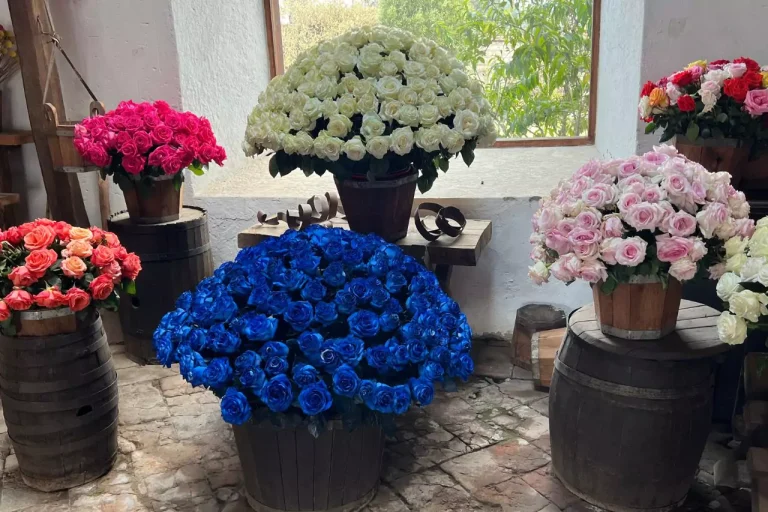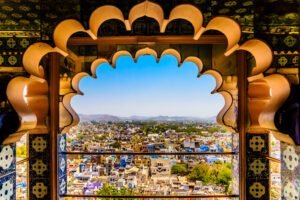Ecuador roses are some of the world’s most renowned flowers, celebrated for their vibrant, large blooms and extra-long stems. Thanks to its unique geographical and climatic conditions, the country produces some of the most sought-after roses globally. With its high-altitude Andean climate, volcanic soil, and consistent equatorial sunlight, Ecuador has become the “Rose Capital of the World“.
Roses play a vital role in Ecuador’s economy, contributing approximately $1 billion annually, with 8 million roses exported daily to countries including the United States, Russia, Europe, and Asia.
For travelers looking to experience Ecuador’s rose industry firsthand, there are plenty of must-visit destinations. This guide will take you on an in-depth journey through Ecuador’s world-famous rose culture.
Table of Contents
What Makes Ecuadorian Roses Unique
Ecuadorian roses are celebrated for their unparalleled beauty and quality, standing out among the world’s finest blooms. But what makes these roses truly special? Let’s explore the unique factors that set them apart.
Perfect Climate and Geography
The secret to Ecuador’s exceptional roses lies in its geography and climate. These natural advantages create the ideal conditions for growing roses of unmatched size and vibrancy.
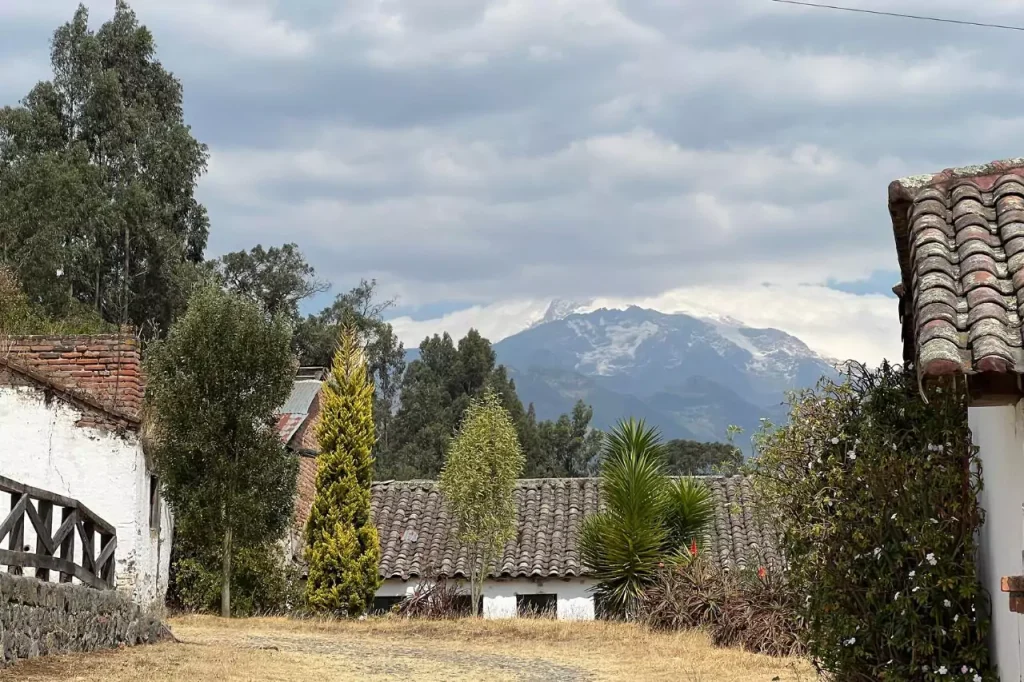
Ecuador’s natural conditions create the ideal environment for rose cultivation:
- Altitude: Most rose farms are located between 9,200 and 9,800 feet above sea level, providing intense sunlight during the day and cooler nights, which result in larger blooms and longer stems.
- Equatorial Sunlight: Ecuador sits on the equator, meaning it receives 12 hours of consistent sunlight every day, allowing for a stable growing cycle year-round.
- Volcanic Soil: The nutrient-rich volcanic soil in regions like Cayambe and Tabacundo enhances the quality of the roses, making them healthier, more vibrant, and longer-lasting.
Extra-Long Stems: The Signature of Ecuadorian Roses
Ecuadorian roses are famous for their extra-long stems, reaching up to 35 inches in length. This signature feature results from the unique combination of high altitude, nutrient-rich soil, and specialized growing techniques used by Ecuadorian rose farmers.
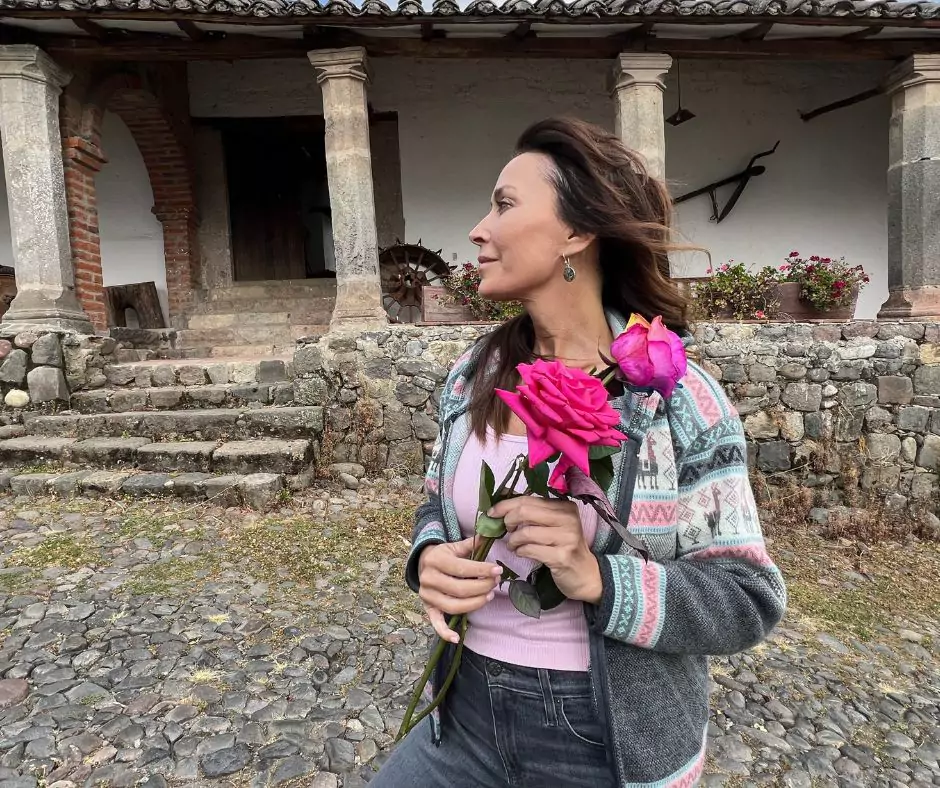
Must-Visit Rose Destinations in Ecuador
Ecuador’s rose culture offers more than just breathtaking flowers. From bustling markets to sprawling farms, these destinations provide visitors with unforgettable experiences tied to the country’s vibrant rose industry.
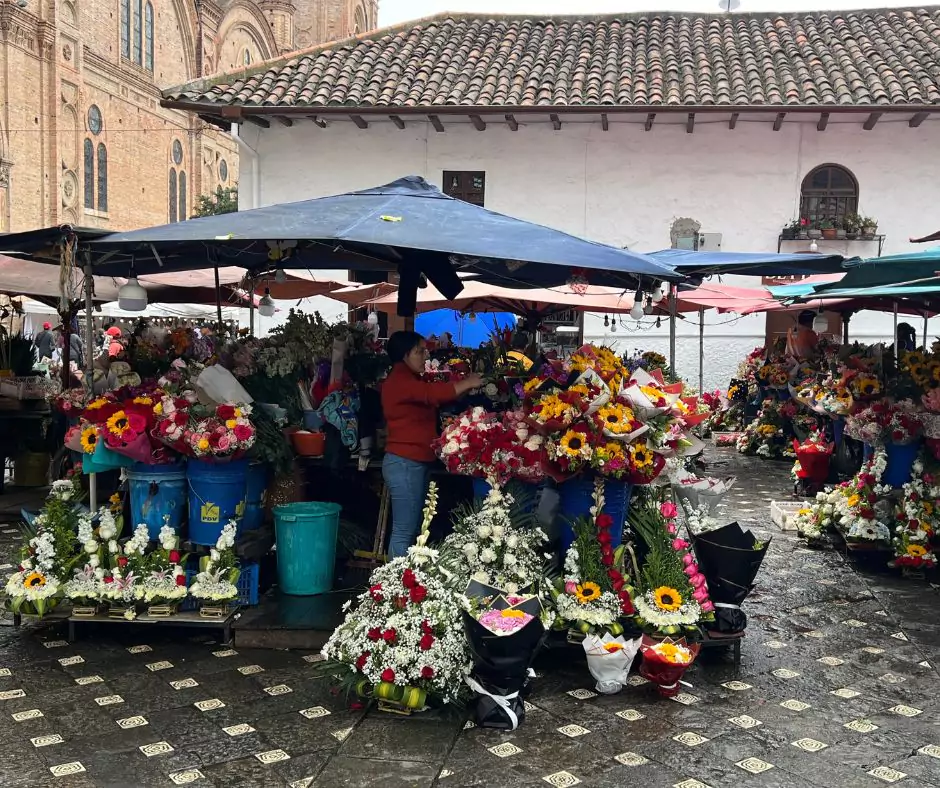
A Visit to Cuenca’s Plaza de las Flores
While visiting Cuenca, a historic city in the Andean Highlands of Southern Ecuador, I wanted to stop and smell the roses—literally. Cuenca sits at an elevation of about 8,400 feet above sea level in the Andes Mountains, approximately 193 miles south of Quito, Ecuador’s capital. It’s a journey of about 8 hours by car or 1 hour by plane.
The region’s high elevation and location on the equator provide the perfect climate for roses to thrive. With 12 hours of consistent sunlight, cool nights, and no extreme seasons, this environment produces some of the most beautiful roses in the world.
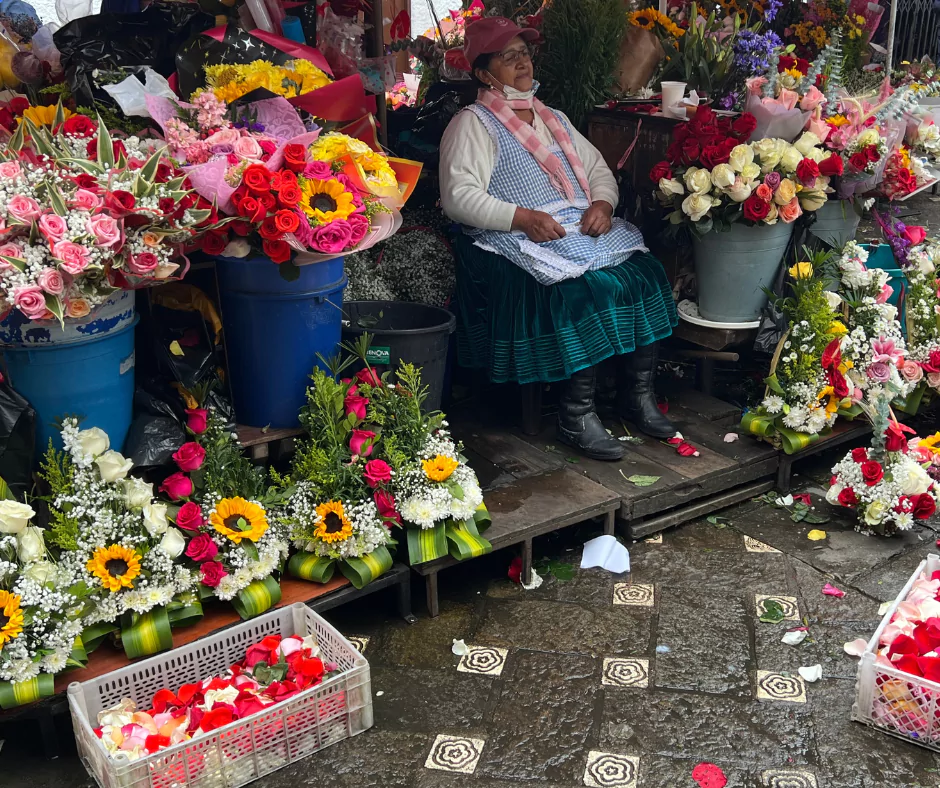
One of the highlights of my trip to Cuenca was visiting the Plaza de las Flores, a vibrant flower market located in the city’s historic center. This market is where local rose growers gather to sell their flowers directly to the public. Unlike large-scale exporters, most of the vendors here are small rose farmers, offering a wide variety of blooms at incredibly affordable prices.
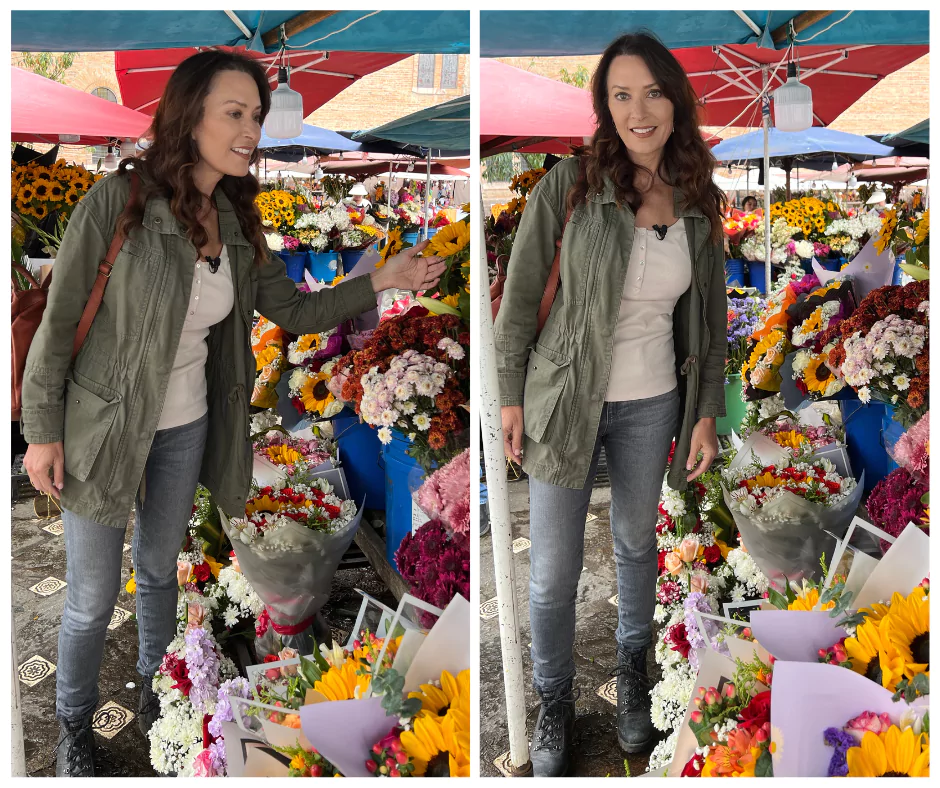
I was amazed to find that roses sold here cost just $2 to $5 per dozen, a mind-blowing deal considering their size and quality. The sight of the vibrant roses stacked in overflowing buckets was absolutely mesmerizing.
Supporting these small vendors felt especially meaningful to me. As my guide, Wilson Galarza, explained:
“Roses are one of Ecuador’s top ten exports, contributing approximately 1 billion dollars a year to the country’s economy. Ecuador exports approximately 8 million roses per day.”
Purchasing directly from local vendors helps support the livelihoods of Ecuadorian farmers and artisans.
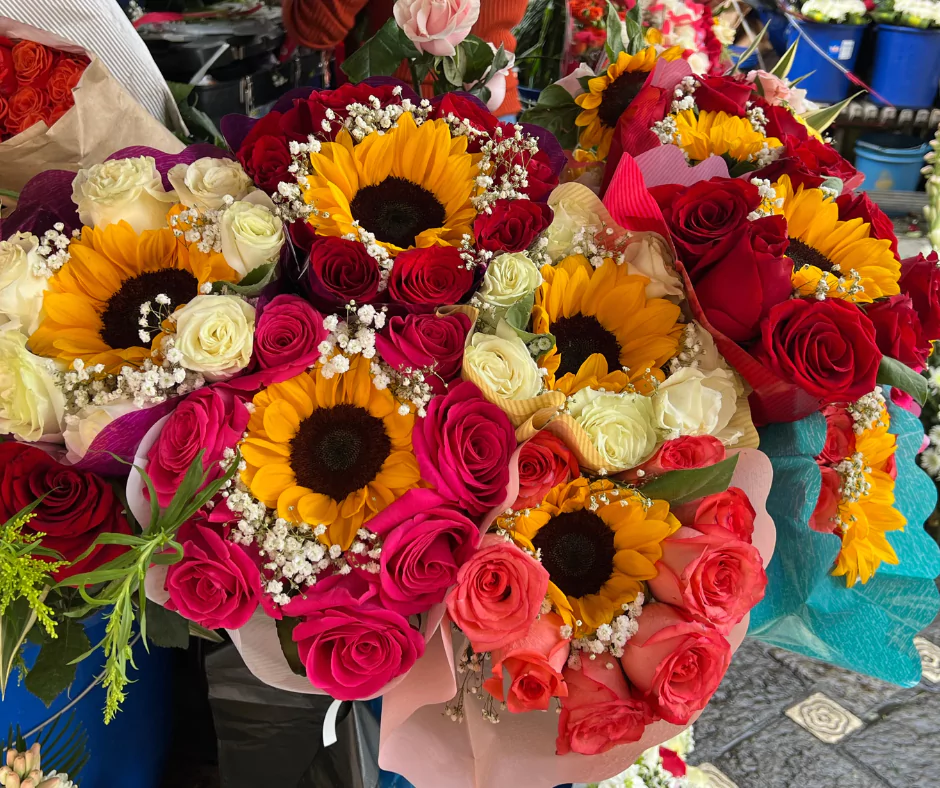
Ecuador’s Top Rose-Producing Regions
As Wilson shared more about Ecuador’s rose industry, he pointed out that 99% of the roses Ecuador exports are cultivated in three provinces:
- Pichincha Province: Home to Quito, Ecuador’s capital, this province is the largest producer of roses. The towns of Cayambe and Tabacundo, known as the “Rose Capital of the World,” are located here. These areas are rich in volcanic soil and sit at an altitude of 9,200–9,800 feet, making them ideal for rose cultivation.
- Imbabura Province: This region, home to the famous city of Otavalo, is another major rose producer, with its own unique varieties and farms.
- Cotopaxi Province: Situated near the towering Cotopaxi volcano, this province is known for its breathtaking scenery and thriving rose farms.
In addition to these major rose-growing regions, smaller farms in Azuay Province (where Cuenca is located) also contribute to the country’s rose industry. Many of these smaller growers sell their flowers at local markets like the Plaza de las Flores.
Cayambe & Tabacundo – Heart of the Ecuadorian Rose Industry
As we drove through Cayambe, a city about 43 miles northeast of Quito, large greenhouses growing roses dotted the countryside. The Pichincha Province is home to Ecuador’s largest rose farms, thriving at an altitude of 9,200–9,800 feet.
“Roses are one of Ecuador’s top ten exports, contributing approximately $1 billion a year to the country’s economy. Ecuador exports approximately 8 million roses per day,” Wilson explained.
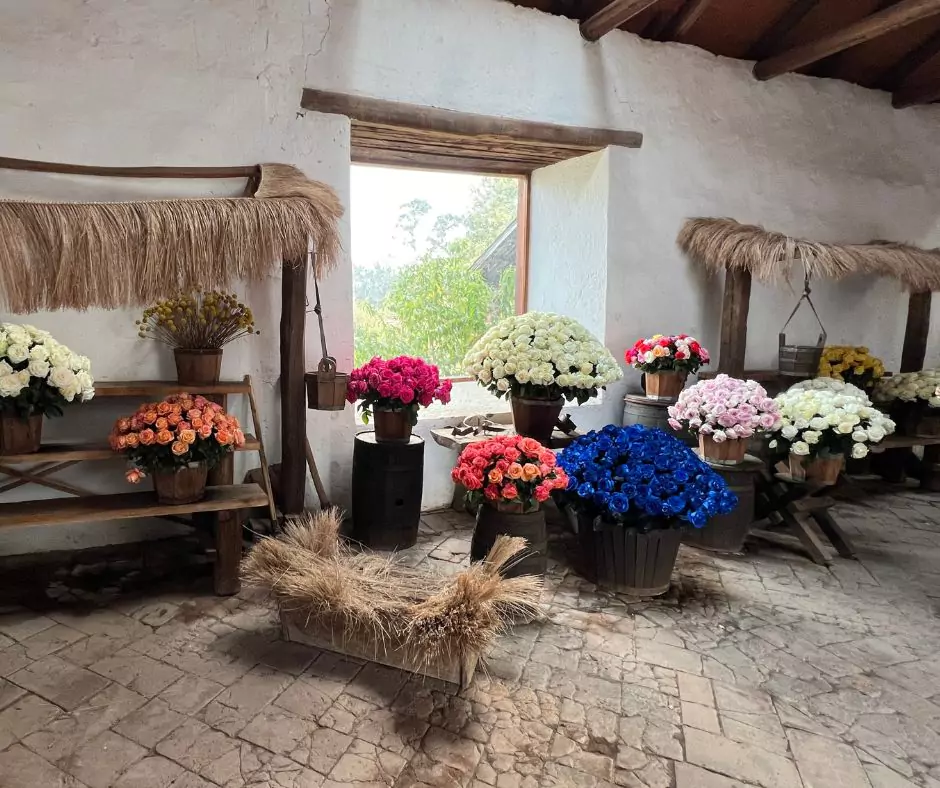
Top Rose Farms to Visit in Ecuador
For travelers interested in exploring Ecuador’s rose industry firsthand, visiting local rose farms offers an immersive experience. Here are some notable farms to consider:
- Hacienda La Compañía: Located in the picturesque Cayambe Valley, this historic estate seamlessly blends rose cultivation with cultural heritage. Visitors can tour the expansive rose plantations, explore the beautifully preserved hacienda adorned with antique furnishings, and enjoy a traditional Ecuadorian meal amidst lush gardens. The estate offers a comprehensive experience, showcasing the journey of a rose from bud to bloom.
- Rosadex Rose Farm: Situated near Quito, Rosadex is renowned for its innovative cultivation techniques and a vast array of rose varieties. A guided tour provides insights into the meticulous processes involved in producing high-quality roses, from greenhouse management to post-harvest handling. The farm’s commitment to sustainability and excellence makes it a highlight for any floral enthusiast.
The Broader Impact of Ecuador Rose Industry
Ecuador’s rose industry is not only a symbol of beauty but also a vital economic and cultural pillar for the nation. Its impact stretches beyond floriculture, touching lives and shaping communities.
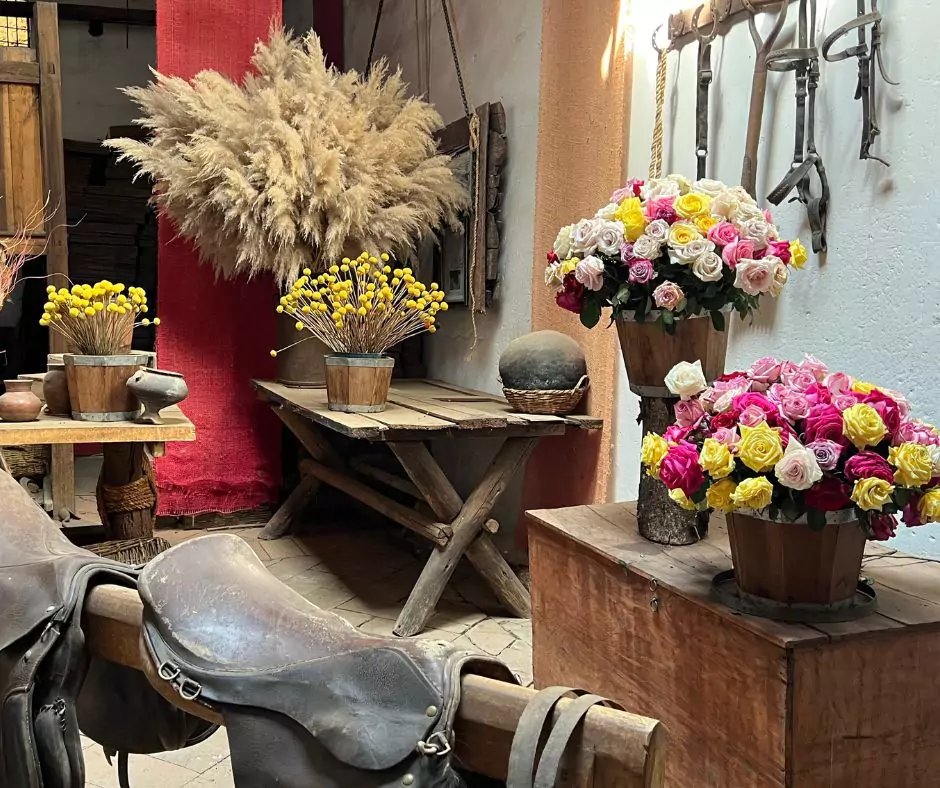
The Economic Impact of Rose Cultivation in Ecuador
The rose industry is a cornerstone of Ecuador’s economy, contributing over $1 billion annually and positioning the country as the world’s third-largest exporter of cut flowers. This sector provides employment to more than 48,000 Ecuadorians, with a significant portion being women from rural communities. The industry’s influence extends beyond economics, fostering social development and infrastructure improvements in these areas.
Cultural Significance of Roses in Ecuadorian Traditions
Beyond their economic value, roses hold a cherished place in Ecuadorian culture. They feature prominently in local festivals, religious ceremonies, and daily life. For instance, during the annual “Fiesta de las Flores y las Frutas” in Ambato, vibrant rose displays celebrate the region’s floral heritage. Roses also adorn religious altars and are used in cultural celebrations as symbols of beauty and devotion.
The Global Reach of Ecuador Roses
Ecuador’s roses aren’t just loved locally—they’re a global phenomenon. The country exports most of its roses to over 100 countries, with the United States, Russia, Europe, and Asia being the top markets. As I learned from Wilson, roses are a critical part of Ecuador’s economy, and the demand for their vibrant, high-quality blooms shows no signs of slowing down.
Driving through the countryside near Cayambe, I saw large greenhouses dotting the landscape—proof of the scale and dedication of Ecuador’s rose industry. Many of these farms are certified for sustainable and ethical practices, adhering to international standards such as Rainforest Alliance or Fair Trade.
Unique Experiences for Rose Enthusiasts in Ecuador
For travelers seeking to immerse themselves in Ecuador’s rose culture, there are experiences that go beyond simply admiring flowers. These activities bring you closer to the artistry and traditions behind the blooms.
Exploring Hacienda El Molino San Juan
While in Cayambe, I visited Hacienda El Molino San Juan, a historic estate just outside the city. More than just a farm, this hacienda operates as a restaurant, museum, boutique hotel, and rose showroom.
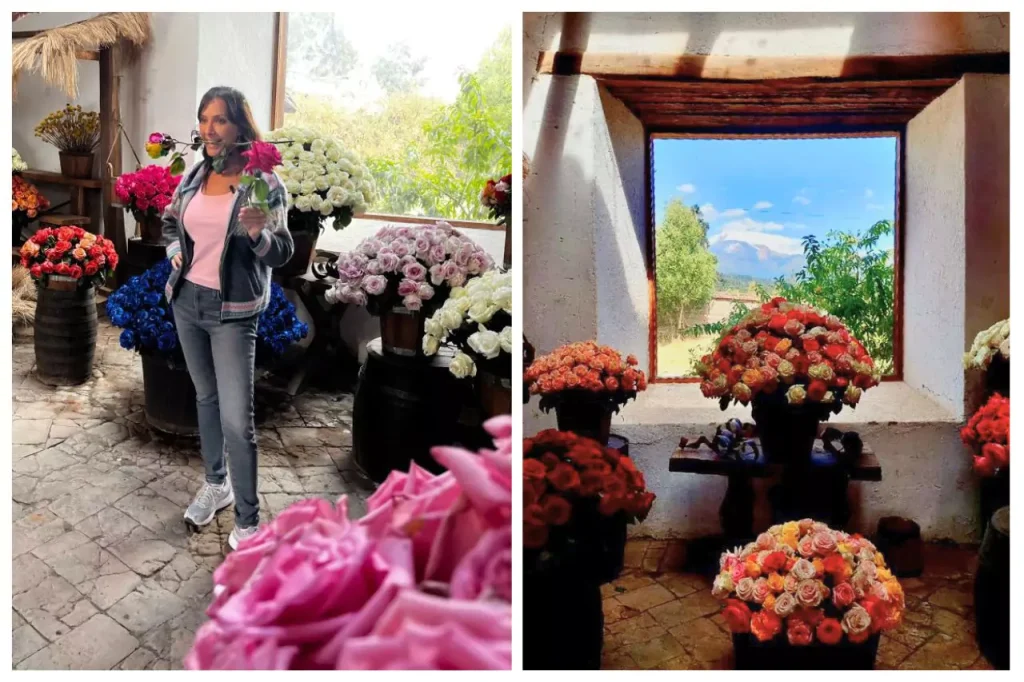
Walking into the rose showroom felt like stepping into a kaleidoscope of colors. I was amazed by rare rose varieties, including cobalt blue roses and rainbow-hued roses, which I learned are created by dyeing white blooms with vibrant pigments. The artistry and creativity behind these unique roses were truly remarkable.
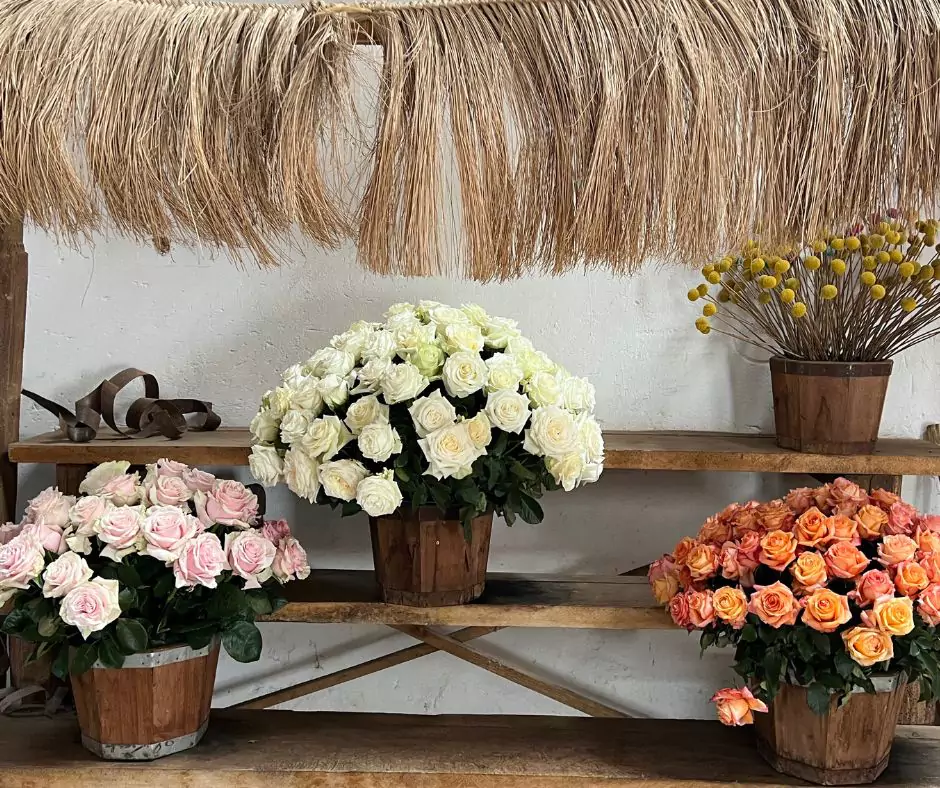
Surrounded by the Andes Mountains, the hacienda blended history and natural beauty, making it a must-visit destination for flower lovers.
Sustainability in Ecuador’s Rose Industry
It was heartening to learn that many Ecuadorian rose farms prioritize sustainability. These farms use eco-friendly practices like integrated pest management and drip irrigation to minimize their environmental impact. Additionally, certifications like Rainforest Alliance and Fair Trade ensure that farms meet high standards for ethical and sustainable practices.
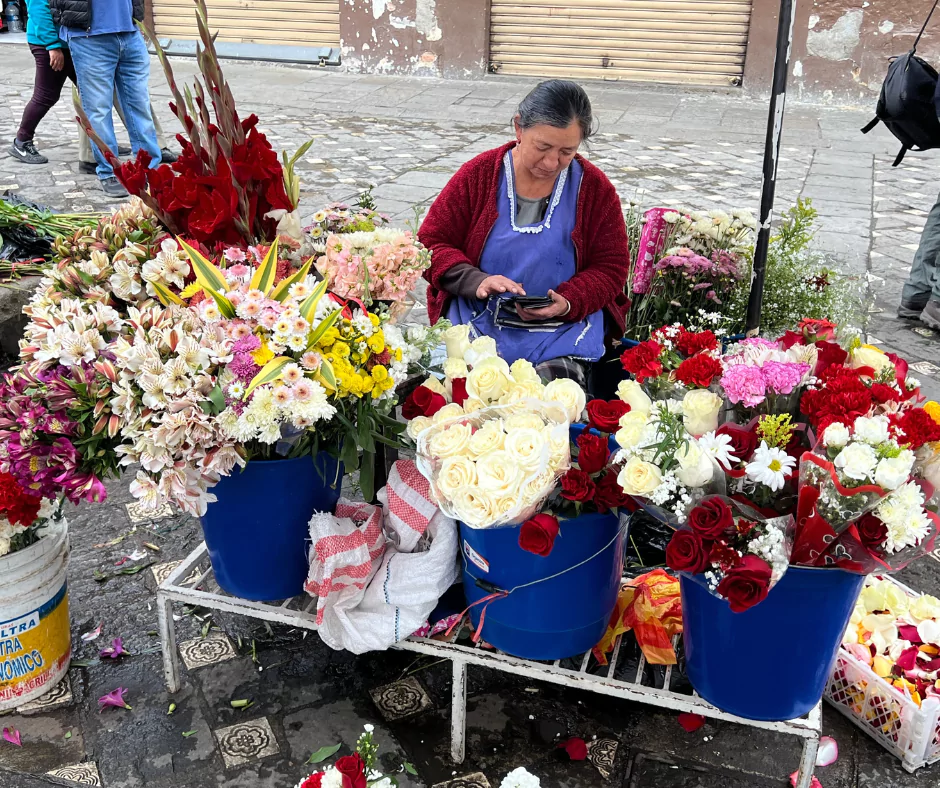
Wilson explained that these certifications not only protect the environment but also ensure fair wages and better working conditions for farm workers, many of whom are women. Knowing this made me appreciate Ecuadorian roses even more. They’re not just beautiful, they’re also produced with care for both people and the planet.
Tips for Visiting Ecuador’s Rose Regions
If you’re planning your own rose-themed adventure in Ecuador, here are some tips to make the most of your trip:
- Visit Local Markets: Don’t miss places like Plaza de las Flores in Cuenca, where you can buy stunning roses directly from small farmers at unbeatable prices.
- Tour a Rose Farm: Many farms in Cayambe and Cotopaxi offer guided tours, giving you an up-close look at the cultivation process and a chance to see the roses in all their glory.
- Combine Attractions: Pair your rose farm visits with nearby landmarks like Cotopaxi National Park or the Otavalo Market for a well-rounded experience.
- Timing: Roses bloom year-round in Ecuador, but visiting around Valentine’s Day or Mother’s Day offers a unique opportunity to see the industry in full swing.
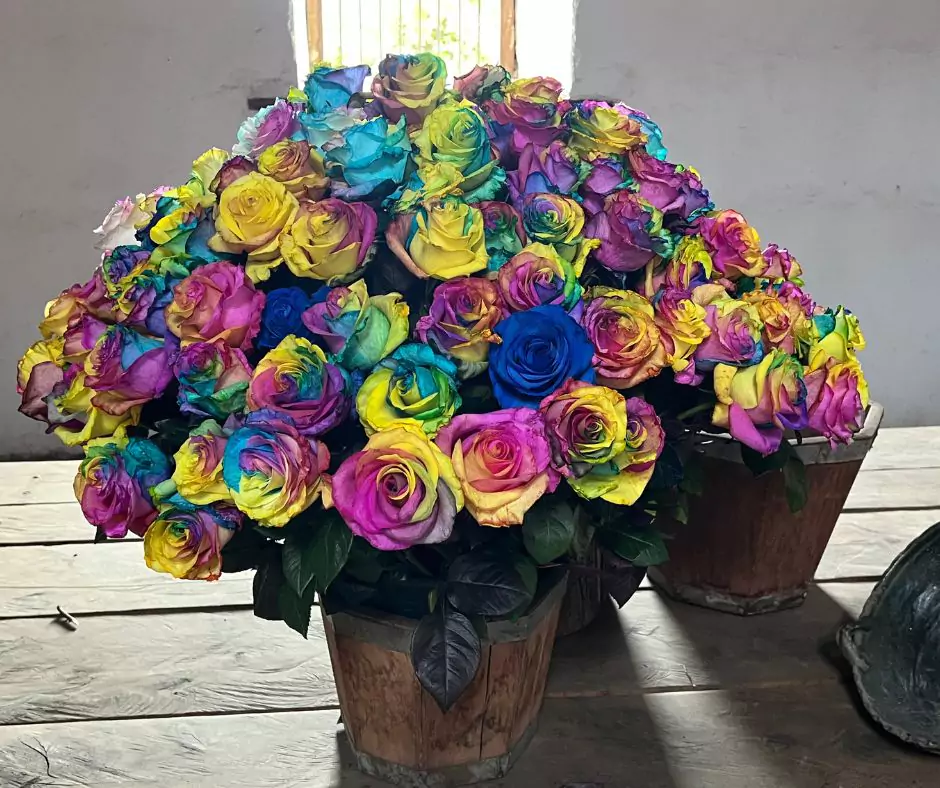
The Beauty and Impact of Ecuador Roses
Ecuador roses are more than just flowers, they are a testament to the country’s natural beauty, cultural heritage, and the dedication of its people. From vibrant flower markets to sprawling rose farms, every experience is a celebration of craftsmanship and care.
If you are seeking a unique travel adventure, Ecuador’s rose regions offer an unforgettable journey. By supporting this thriving industry, you’re not just admiring roses, you’re contributing to the livelihoods of local farmers and the preservation of sustainable practices.
So, the next time you hold a bouquet of roses, think of their journey from the Andean Highlands. Plan your visit to Ecuador, where every bloom tells a story of beauty, passion, and pride.
More Ecuador Travel Tips and Guide For You
5 Reasons Why Horseback Riding in Ecuador is a Must-Do
In Search of the True Equator Line in Ecuador
How Microentrepreneurship Empowers Ecuador’s Culture Bearers
5 Best Hotels in Quito Ecuador









